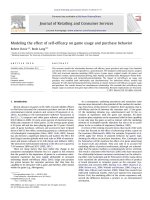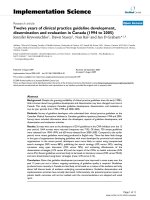Lecture Retail and merchant banking – Lecture 19
Bạn đang xem bản rút gọn của tài liệu. Xem và tải ngay bản đầy đủ của tài liệu tại đây (4.64 MB, 37 trang )
Revise Lecture 19
•
Basic Lending
Principles
Basic Lending Principles
•
Safety Issues
Basic Lending Principles
Safety Issues
•
•
The persistent failures of banks to lend
sensibly in Pakistan and in many other
countries have brought the question of
safety in lending to the fore;
Why do banks persistently lend so
imprudently and how should lending be
done at minimum risk?
Basic Lending Principles
Safety Issues
•
•
One essential problem is the human and
managerial challenge of motivating
employees of banks to cater to the interest
of the owners (shareholders) of the bank.
The history of banking is replete with
episodes of employees favouring friends
and relatives with loans.
Basic Lending Principles
Safety Issues
•
•
In some countries, there are well-defined
market rates for bribes for obtaining loans
from banks.
This problem is also present in Pakistan,
though the record of Pakistan’s banking
system in this aspect is much better than
that of many other countries.
Basic Lending Principles
Safety Issues
•
•
Another aspect of the problems of banks
concerns prudent levels of leverage.
A bank is a financial intermediary with
fairly small equity capital, which borrows
money from depositors and invest it into
risky assets. This involves a high degree
of leverage
Basic Lending Principles
Safety Issues
•
•
Leverage, at the level of the bank, is
dangerous regardless of the quality of
credit analysis which has gone into each
loan.
High leverage generates high risk and
high returns. If high returns are obtained,
the bank takes the profits but it is
protected from high losses by the
government.
Basic Lending Principles
Safety Issues
•
•
Regulators have tried many policy
initiatives aimed at obtaining a banking
system which has controlled leverage,
high quality lending and thus, a reduced
risk of failure.
These include capital adequacy
requirements based on clumsy
measurement of risk, prohibition of lending
against real estate, restrictions on lending
Basic Lending Principles
Safety Issues
•
•
•
A riskless loan is one that is fully
collateralised using actively traded assets.
These assets should be traded objects so
that a ‘market to market’ can be done
daily, to ensure that the collateral is always
larger than the outstanding loan.
The value of the asset that is measured
when marking to market should be the
•
Diversification of Risk
Basic Lending Principles
Diversification of Risk
•
•
•
Diversification in banking has been a topic
of discussion in the literature for decades.
It effects on performance, risk, efficiency
and firm value have been examined
extensively.
Diversification does have a significant
impact on a bank’s risk as well as its
performance.
Basic Lending Principles
•
Benefits of Diversification
Basic Lending Principles
Benefits of Diversification
•
•
One of the most common benefits
associated with respect to diversification is
a lower cost of capital.
Banks, with some level of global
diversification have access to different
capital markets which could lead to a
lower cost of funds through a larger
deposit base.
Basic Lending Principles
Benefits of Diversification
•
•
Furthermore, the potential for more
efficient internal capital markets is another
of cited benefit to diversification.
Another benefit associated with activity
diversification is the ability to gain
economies of scale / scope for the
organization.
Basic Lending Principles
Benefits of Diversification
•
An example might be bank which collects
information credit information on potential
borrowers. With this information, the bank
may be able to offer these potential clients
insurance products or underwriting
services at a lower cost because much of
the information needed has already been
collected when evaluating the loan
application.
Basic Lending Principles
Benefits of Diversification
•
•
Benefits associated with market power
have also been advanced. The argument
suggests that banks may diversify their
activities or their operations geographically
to gain or maintain market share.
Finally, an important benefit that has been
proposed by some is the ability for
organizations to reduce earnings volatility
by spreading operations across areas with
Lecture 20
•
Loans and Advances
Loans and Advances
•
•
Lending money is one of the two major
activities of any bank.
The bank acts as an intermediary between
the people who have the money to lend
and those need money to carry out
business transactions.
Loans and Advances
•
•
•
A loan is granted for a specific time period.
Generally, commercial banks provide
short-term loans. But term loans, i.e. loans
for more than a year, may also be granted.
The borrower may be given the entire
amount in lump sum or in instalIments.
Loans and Advances
•
•
Loans are generally granted against or in
exchange of the ownership (physical or
constructive)of various type of tangible
items.
Some of the securities against which the
banks lend are;
Loans and Advances
1.
Commodities
2.
Debts
3.
Financial instruments
4.
Real estate
5.
Automobiles
6.
Consumer durable goods
•
Classification of
Loans
Loans and Advances
•
Bank loans can be classified as follows
according to the activity being financed;
1.
Priority sector lending
2.
Commercial lending









